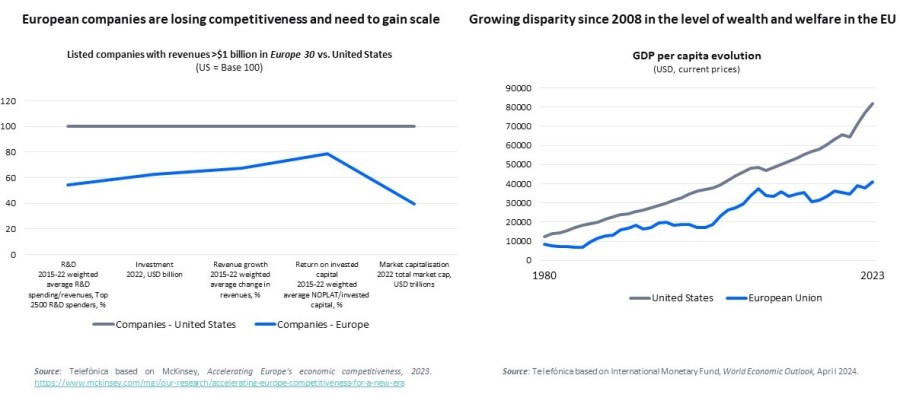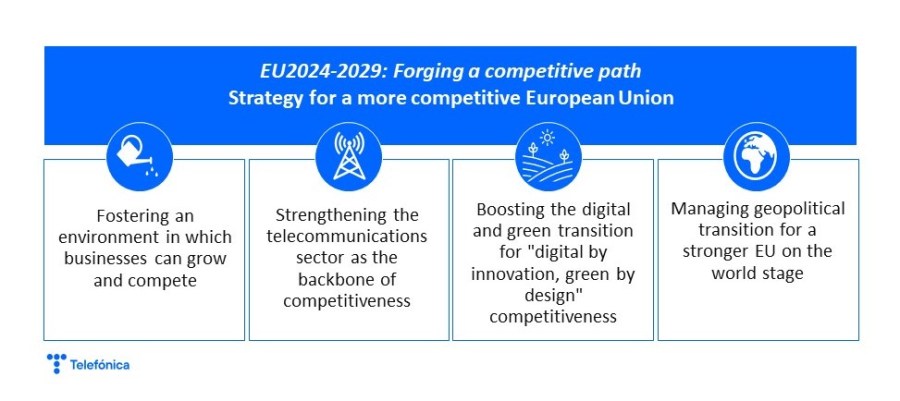A new institutional cycle begins in Europe with the European Parliament elections on 6-9 June. This moment marks the beginning of a crucial period for the European Union (EU), where public policies and legislative initiatives in the period 2024-2029 will be decisive for the future prosperity of the region.
The starting point for the European institutions will be a profound reflection on where Europe wants to be in the next decade and how to ensure the economic security, strategic autonomy and stability of its society in an increasingly fragmented, uncertain and complex global context.
With the start of the new cycle, we present a series of articles that, under the theme EU 2024-2029: Forging a competitive path, will explore the pillars that we at Telefónica believe are key to strengthening regional competitiveness and successfully navigating the geopolitical, digital, and green transitions. This first post focuses on the starting point: the state of European competitiveness.
The challenge of EU competitiveness
In the current global scenario, rethinking the competitiveness strategy is a priority for the EU. This is confirmed after the European Commission asked Mario Draghi and Enrico Letta to draft a report on Competitiveness and the European Single Market respectively, whose guidelines will undoubtedly help to shape the new European legislature.
With the publication of Letta’s report and in anticipation of Draghi’s, several indicators warn of the loss of competitiveness of European companies and the need to increase their scale. The European Round Table (ERT) already warned of Europe’s economic slowdown and low productivity growth compared to the United States or China. This means that Europe has a lower capacity to innovate and invest in technology and human capital, widening economic and social disparities.
Indeed, the International Monetary Fund notes that the EU’s share of world GDP, in purchasing power parity terms, has fallen significantly from 23% to 14% in about three decades. This economic weakening is reflected in per capita income, an indicator of a society’s wealth and economic stability. In these terms, the gap between the EU and the US has widened by 68 percentage points since 2008.

The challenge of the technological and digital divide
This loss of competitiveness is particularly acute in the technological and digital domain, an area that is reshaping global power and the well-being of current and future generations, with the US and China vying for leadership while Europe lags behind.
In the State of the Digital Decade 2023 report, the European Commission highlights that the EU’s global share of the ICT market has fallen drastically over the last decade, from 21.8% in 2013 to 11.3% in 2022, while the US share has risen from 26.8% to 36%.
In particular, the EU faces a significant gap in the development and adoption of new technologies such as artificial intelligence (AI), 5G or quantum computing, in an era of ever shorter innovation cycles. The lack of scale and momentum in technological innovation is reflected, for example, in private investment in generative AI in 2023: $1.7 billion in Europe compared to $23 billion in the US, according to the McKinsey Global Institute.
There is no doubt that in the era of the digital and global economy, competitiveness must revolve around digital leadership and recognise the fundamental role of the telecoms sector, with its infrastructure, digital services, and reach, in driving productivity, economic growth, job creation and prosperity.
However, the sector is losing competitiveness in the EU, affecting its rate of innovation and investment. According to ETNO, while the US invests €240 per capita in network deployment, Europe invests only €109, less than half. The coming years will be crucial for digital leadership and for the telecoms sector as its driver.
Risks of further widening the EU’s competitiveness gap
Strengthening competitiveness is essential for the EU’s economic sustainability and future stability. Continued loss of competitiveness would have economic, social, and geopolitical consequences. Slower economic growth affects innovation capacity, job creation, wealth creation and social welfare. In addition, a declining relevance in the global economy would weaken the EU’s ability to defend its strategic interests on the international stage, thus undermining its strategic autonomy.
Similarly, strengthening digital autonomy is crucial in an environment where digital and technological leadership translates into economic and geostrategic power. The transformative nature of technologies such as AI and 5G drives innovation and productivity, creating competitive advantages that are amplified by global digital markets and winner-take-all dynamics. This competitiveness factor affects both the economy and geopolitics, where leadership in these areas is a strategic goal and its absence a vulnerability to economic security.
Given the current leadership of China and the United States, if the EU does not strengthen its digital autonomy, it risks consolidating its position as a ‘follower’, adopting foreign technologies with the risk that they will be developed under different regulations and values to those of Europe. Indeed, according to the European Commission, the EU currently depends on foreign countries for over 80% of digital products, services, infrastructure, and intellectual property.
The opportunity of the EU 2024-2029 European cycle to boost competitiveness
This context underlines the importance of competitiveness for the EU. The European cycle 2024-2029 therefore presents an opportunity to create a favourable environment for investment and innovation, boosting competitiveness, digital autonomy and regional cohesion. Recognising the crucial role of European companies in building a prosperous future is essential and, in the current context, speed of implementation is key.
In the next posts, we will explore the key pillars of Telefónica’s proposed competitiveness strategy for a stronger European Union, along with specific recommendations. These pillars are:










